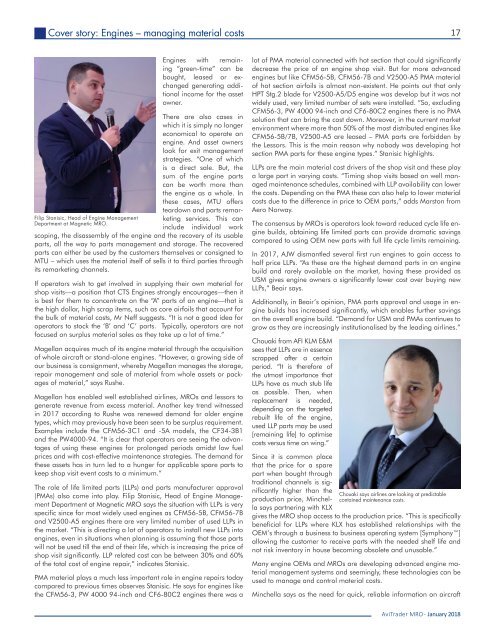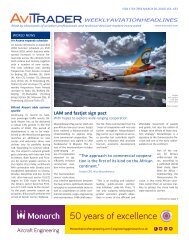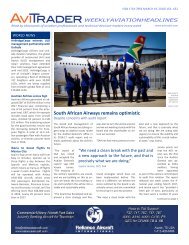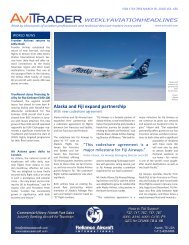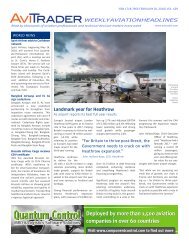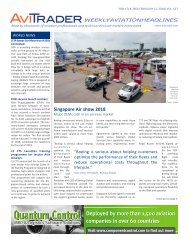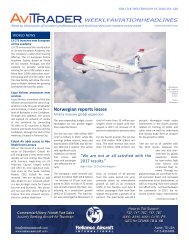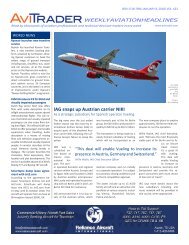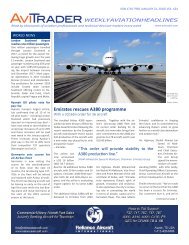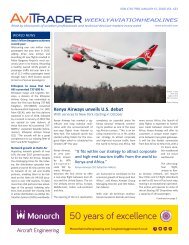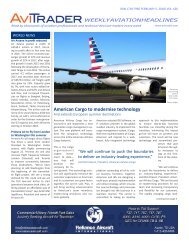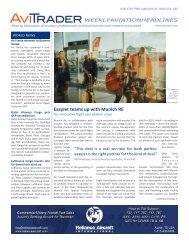AviTrader MRO Magazine 2018-01
AviTrader MRO Magazine 2018-01
AviTrader MRO Magazine 2018-01
You also want an ePaper? Increase the reach of your titles
YUMPU automatically turns print PDFs into web optimized ePapers that Google loves.
Cover story: Engines – managing material costs<br />
17<br />
Filip Stanisic, Head of Engine Management<br />
Department at Magnetic <strong>MRO</strong>.<br />
Engines with remaining<br />
“green-time” can be<br />
bought, leased or exchanged<br />
generating additional<br />
income for the asset<br />
owner.<br />
There are also cases in<br />
which it is simply no longer<br />
economical to operate an<br />
engine. And asset owners<br />
look for exit management<br />
strategies. “One of which<br />
is a direct sale. But, the<br />
sum of the engine parts<br />
can be worth more than<br />
the engine as a whole. In<br />
these cases, MTU offers<br />
teardown and parts remarketing<br />
services. This can<br />
include individual work<br />
scoping, the disassembly of the engine and the recovery of its usable<br />
parts, all the way to parts management and storage. The recovered<br />
parts can either be used by the customers themselves or consigned to<br />
MTU – which uses the material itself of sells it to third parties through<br />
its remarketing channels.<br />
If operators wish to get involved in supplying their own material for<br />
shop visits—a position that CTS Engines strongly encourages—then it<br />
is best for them to concentrate on the “A” parts of an engine—that is<br />
the high dollar, high scrap items, such as core airfoils that account for<br />
the bulk of material costs, Mr Neff suggests. “It is not a good idea for<br />
operators to stock the ‘B’ and ‘C’ parts. Typically, operators are not<br />
focused on surplus material sales as they take up a lot of time.”<br />
Magellan acquires much of its engine material through the acquisition<br />
of whole aircraft or stand-alone engines. “However, a growing side of<br />
our business is consignment, whereby Magellan manages the storage,<br />
repair management and sale of material from whole assets or packages<br />
of material,” says Rushe.<br />
Magellan has enabled well established airlines, <strong>MRO</strong>s and lessors to<br />
generate revenue from excess material. Another key trend witnessed<br />
in 2<strong>01</strong>7 according to Rushe was renewed demand for older engine<br />
types, which may previously have been seen to be surplus requirement.<br />
Examples include the CFM56-3C1 and -5A models, the CF34-3B1<br />
and the PW4000-94. “It is clear that operators are seeing the advantages<br />
of using these engines for prolonged periods amidst low fuel<br />
prices and with cost-effective maintenance strategies. The demand for<br />
these assets has in turn led to a hunger for applicable spare parts to<br />
keep shop visit event costs to a minimum.”<br />
The role of life limited parts (LLPs) and parts manufacturer approval<br />
(PMAs) also come into play. Filip Stanisic, Head of Engine Management<br />
Department at Magnetic <strong>MRO</strong> says the situation with LLPs is very<br />
specific since for most widely used engines as CFM56-5B, CFM56-7B<br />
and V2500-A5 engines there are very limited number of used LLPs in<br />
the market. “This is directing a lot of operators to install new LLPs into<br />
engines, even in situations when planning is assuming that those parts<br />
will not be used till the end of their life, which is increasing the price of<br />
shop visit significantly. LLP related cost can be between 30% and 60%<br />
of the total cost of engine repair,” indicates Stanisic.<br />
PMA material plays a much less important role in engine repairs today<br />
compared to previous times observes Stanisic. He says for engines like<br />
the CFM56-3, PW 4000 94-inch and CF6-80C2 engines there was a<br />
lot of PMA material connected with hot section that could significantly<br />
decrease the price of an engine shop visit. But for more advanced<br />
engines but like CFM56-5B, CFM56-7B and V2500-A5 PMA material<br />
of hot section airfoils is almost non-existent. He points out that only<br />
HPT Stg.2 blade for V2500-A5/D5 engine was develop but it was not<br />
widely used, very limited number of sets were installed. “So, excluding<br />
CFM56-3, PW 4000 94-inch and CF6-80C2 engines there is no PMA<br />
solution that can bring the cost down. Moreover, in the current market<br />
environment where more than 50% of the most distributed engines like<br />
CFM56-5B/7B, V2500-A5 are leased – PMA parts are forbidden by<br />
the Lessors. This is the main reason why nobody was developing hot<br />
section PMA parts for these engine types.” Stanisic highlights.<br />
LLPs are the main material cost drivers of the shop visit and these play<br />
a large part in varying costs. “Timing shop visits based on well managed<br />
maintenance schedules, combined with LLP availability can lower<br />
the costs. Depending on the PMA these can also help to lower material<br />
costs due to the difference in price to OEM parts,” adds Marston from<br />
Aero Norway.<br />
The consensus by <strong>MRO</strong>s is operators look toward reduced cycle life engine<br />
builds, obtaining life limited parts can provide dramatic savings<br />
compared to using OEM new parts with full life cycle limits remaining.<br />
In 2<strong>01</strong>7, AJW dismantled several first run engines to gain access to<br />
half price LLPs. “As these are the highest demand parts in an engine<br />
build and rarely available on the market, having these provided as<br />
USM gives engine owners a significantly lower cost over buying new<br />
LLPs,” Beair says.<br />
Additionally, in Beair’s opinion, PMA parts approval and usage in engine<br />
builds has increased significantly, which enables further savings<br />
on the overall engine build. “Demand for USM and PMAs continues to<br />
grow as they are increasingly institutionalised by the leading airlines.”<br />
Chouaki from AFI KLM E&M<br />
sees that LLPs are in essence<br />
scrapped after a certain<br />
period. “It is therefore of<br />
the utmost importance that<br />
LLPs have as much stub life<br />
as possible. Then, when<br />
replacement is needed,<br />
depending on the targeted<br />
rebuilt life of the engine,<br />
used LLP parts may be used<br />
[remaining life] to optimise<br />
costs versus time on wing.”<br />
Since it is common place<br />
that the price for a spare<br />
part when bought through<br />
traditional channels is significantly<br />
higher than the<br />
production price, Minchella<br />
says partnering with KLX<br />
Chouaki says airlines are looking at predictable<br />
contained maintenance costs.<br />
gives the <strong>MRO</strong> shop access to the production price. “This is specifically<br />
beneficial for LLPs where KLX has established relationships with the<br />
OEM’s through a business to business operating system [Symphony]<br />
allowing the customer to receive parts with the needed shelf life and<br />
not risk inventory in house becoming obsolete and unusable.”<br />
Many engine OEMs and <strong>MRO</strong>s are developing advanced engine material<br />
management systems and seemingly, these technologies can be<br />
used to manage and control material costs.<br />
Minchella says as the need for quick, reliable information on aircraft<br />
<strong>AviTrader</strong> <strong>MRO</strong> - January <strong>2<strong>01</strong>8</strong>


